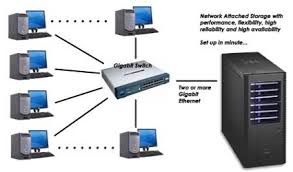Network attached storage (NAS) is a lot like other storage area network (SAN) type systems. It does not directly connect to a storage device via a controller or initiator, but rather operates as a file server for the network. The system is developed to be streamlined, allowing access to data for a specific workgroup. NAS is, for all intents and purposes, a specifically designed computer dealing solely with data transfer, storage and security within a network. It works via Ethernet connections and to this end is relatively fast. NAS is an emerging technology and in order to make informed decisions about using it as a storage solution, we need to understand it fully.
What is NAS?
A NAS device is a specially designed computer, created with specific hardware for the purpose of offering a dedicated file serving solution to a local area network. NAS allows locally connected devices to share storage space, allowing them to expand past the boundaries of their own hardware limitations. Currently a lot of NAS systems are designed to be used with RAID disk systems, allowing for redundant storage in case of disk failure. The major difference NAS devices have from traditional computing systems is that they do not have a display or an installed keyboard/mouse setup. This is because they are not designed to be used like a regular computer system, but solely for the purpose of controlling input and output from the mounted hard disks. Operating systems on these NAS machines can range from Windows to proprietary operating systems developed to streamline data transfer.
The Positives and Negatives of NAS
NAS grants rapid file access for all machines connected to it, an easy way to share data across a network, the ability to mirror a drive, the ability to increase the capacity for storage on localized devices, redundancy in data storage and affordability. Initially, NAS systems were developed to be a more affordable solution for group storage than SAN’s. The most apparent drawback of NAS’s is the fact that they are extremely inefficient at transferring large blocks of data. This may not be a problem if archiving software is used to break the file up into more manageable bits.
The take-away from this is that Network Attached Storage (NAS) is a much more affordable storage solution than other competing SAN solutions. However, even though they may be affordable, there is always the concern that they are less flexible and less competent in dealing with large files. If you’re planning on using a storage system in an office environment that deals with the transfer of large files, then an NAS is probably not the choice you’re looking for. In any other situation, it may be a solution worth investigating.






